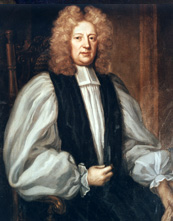Peter Browne (theologian) facts for kids

Peter Browne (born around 1665 – died August 27, 1735) was an Irish Anglican priest. He later became a bishop in the Church of Ireland for the areas of Cork and Ross.
Contents
Who Was Peter Browne?
Peter Browne was an important religious leader and writer in Ireland. He was known for his strong beliefs and his clear way of speaking. He lived a simple life and was very kind to others.
Early Life and Education
Peter Browne was born in County Dublin, Ireland. In 1682, when he was about 17, he started studying at Trinity College Dublin. This is a famous university in Ireland. He stayed there for ten years and became a fellow, which means he was a senior member of the college.
In 1699, he became the Provost of Trinity College. This is like being the head of the college. In the same year, he wrote a book answering another book called "Christianity not Mysterious." His book was seen as a very good reply.
His Role as Bishop
In 1710, Peter Browne was made the bishop of Cork and Ross. This was a big responsibility, overseeing many churches and priests. He held this important position until he passed away in 1735.
Important Ideas and Writings
Peter Browne wrote several important books and pamphlets. These writings shared his ideas about religion and understanding God.
His two most famous books are:
- Procedure, Extent, and Limits of the Human Understanding (published in 1728). This book looked closely at the ideas of another famous thinker, John Locke.
- Things Divine and Supernatural conceived by Analogy with Things Natural and Human (published in 1733). This book is often called the Divine Analogy.
What is Analogy?
In his Divine Analogy, Peter Browne talked about how we can understand God. He believed that we cannot fully understand God's true nature directly. Instead, we can only understand God by comparing divine things to things we know in the natural world. This way of understanding is called analogy. It means seeing similarities between two different things to help explain one of them.
For example, we might say God is like a shepherd. We know what a shepherd does (cares for sheep). This helps us understand how God cares for people, even though God is not literally a shepherd. Browne believed that while we don't understand God exactly as He is, our ideas about Him still connect to a real truth.

